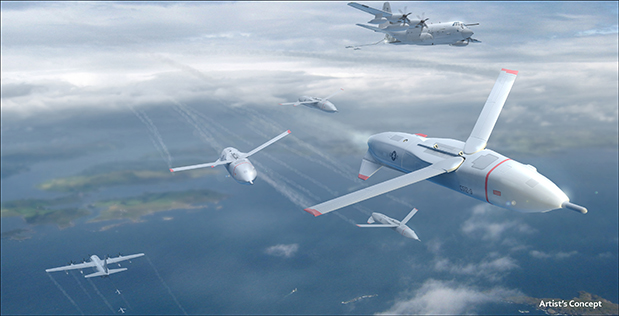

| Online: | |
| Visits: | |
| Stories: |

| Story Views | |
| Now: | |
| Last Hour: | |
| Last 24 Hours: | |
| Total: | |
Airborne Aircraft Carriers and Gremlins
For decades, U.S. military air operations have relied on increasingly capable multi-function manned aircraft to execute critical combat and non-combat missions. Adversaries’ abilities to detect and engage those aircraft from longer ranges have improved over time as well, however, driving up the costs for vehicle design, operation and replacement.
To help make that technology a reality, DARPA has launched the Gremlins program. Named for the imaginary, mischievous imps that became the good luck charms of many British pilots during World War II, the program seeks to show the feasibility of conducting safe, reliable operations involving multiple air-launched, air-recoverable unmanned systems. The program also aims to prove that such systems, or “gremlins,” could provide significant cost advantages over expendable systems, spreading out payload and airframe costs over multiple uses instead of just one.
“Our goal is to conduct a compelling proof-of-concept flight demonstration that could employ intelligence, surveillance and reconnaissance (ISR) and other modular, non-kinetic payloads in a robust, responsive and affordable manner,” said Dan Patt, DARPA program manager.
With an expected lifetime of about 20 uses, Gremlins could fill an advantageous design-and-use space between existing models of missiles and conventional aircraft, Patt said. “We wouldn’t be discarding the entire airframe, engine, avionics and payload with every mission, as is done with missiles, but we also wouldn’t have to carry the maintainability and operational cost burdens of today’s reusable systems, which are meant to stay in service for decades,” he said. Moreover, gremlin systems could be relatively cost-efficient if, as expected, they leverage existing technology and require only modest modifications to current aircraft.
“The Phase 1 program showed the feasibility of airborne UAS launch and recovery systems that would require minimal modification to the host aircraft,” said Scott Wierzbanowski, DARPA program manager. “We’re aiming in Phase 2 to mature two system concepts to enable ‘aircraft carriers in the sky’ using air-recoverable UASs that could carry various payloads—advances that would greatly extend the range, flexibility, and affordability of UAS operations for the U.S. military.”
Gremlins Phase 2 research seeks to complete preliminary designs for full-scale technology demonstration systems, as well as develop and perform risk-reduction tests of individual system components. Phase 3 goals include developing one full-scale technology demonstration system and conducting flight demonstrations involving airborne launch and recovery of multiple gremlins. Flight tests are currently scheduled for the 2019 timeframe.
Collaborative Operations in Denied Environment (CODE) Phase 2 Concept Video
New Concept for Air Warfare
The gremlins’ expected lifetime of about 20 uses could provide significant cost advantages over expendable unmanned systems by reducing payload and airframe costs and by having lower mission and maintenance costs than conventional manned platforms.
Source: http://www.ineffableisland.com/2017/03/airborne-aircraft-carriers-and-gremlins.html



